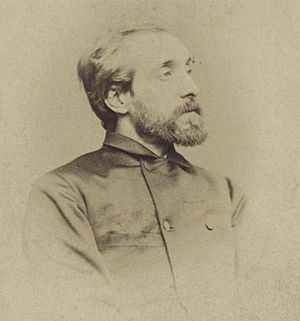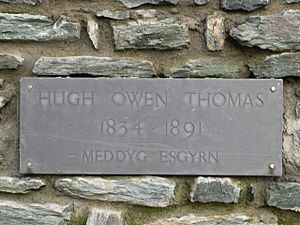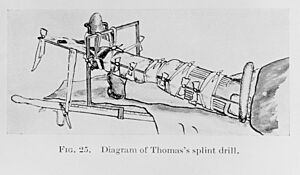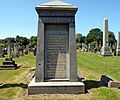Hugh Owen Thomas facts for kids
Hugh Owen Thomas (born August 23, 1834 – died January 6, 1891) was a famous Welsh doctor who specialized in bones and joints. This type of medicine is called orthopaedic surgery. He and his nephew, Robert Jones, are often called the "Fathers of Orthopaedic Surgery" because of their important work.
Thomas came from a family of traditional bone setters. He believed that giving injured bones and joints lots of rest was very important for healing. He made many new tools and methods that changed how doctors treated bone problems. He is especially known for the Thomas splint. This splint was used a lot during World War I. It helped reduce the number of soldiers who died from serious leg injuries from 80% down to just 8%. His ideas also spread to other countries, like the USA.
Contents
His Family's Special Skill
Hugh Owen Thomas's great-grandfather was a young boy who was shipwrecked on Ynys Môn (an island in Wales) between 1743 and 1745. The family who adopted him gave him the name Evan Thomas. He started a family tradition of being bone-setters. This meant they were skilled at fixing broken bones and dislocated joints. Later, scientists found that Evan Thomas's family might have come from the Caucasus mountains, near the border of Georgia and Russia.
Growing Up and Learning
Hugh Owen Thomas was born on Ynys Môn/Anglesey on August 23, 1834. His mother was visiting relatives there. Hugh was a weak child, so his parents sent him to live with his grandparents on Ynys Môn/Anglesey until he was 13. They hoped the countryside would be better for his health than busy Liverpool.
When he was at school, another boy threw a stone at Hugh. It hit him and caused an eye problem called an ectropion eye. After that, Thomas wore an eye patch to protect his eye from the cold air. He also pulled his hat down to stop people from staring.
Hugh was the oldest son of Evan Thomas (who was the grandson of the first Evan Thomas). He went to college at New Brighton until he was 17. He then became an apprentice to Dr. Owen Roberts. Later, he studied at Edinburgh University in 1855. After two terms in Edinburgh, he went to University College London. In 1857, he became a qualified surgeon (MRCS England). He then traveled to Paris to learn more about surgery.
Starting His Own Practice
After studying in France, Hugh Owen Thomas worked with his father, Evan Thomas, for a year. But they often disagreed because his father hadn't gone to medical school like Hugh had. So, Hugh started his own medical practice at 24 Hardy Street, Liverpool.
In 1866, he bought a larger building at 11 Nelson Street, Liverpool. He made it into a big surgery house with two waiting rooms, four consulting rooms, a surgery room, and a workshop. He hired a full-time metalworker and a leather worker. They helped him make the splints and other medical devices he designed. He treated many patients from the Liverpool area.
Thomas was known for his ideas about rest and lining up bones correctly. He believed in these things even before X-rays were discovered! He also strongly encouraged keeping an injured or diseased bone or joint completely still and rested. In 1875, Thomas published his first book, called "Diseases of the Hip, Knee, and Ankle Joints." In this book, he first described his designs for hip and knee splints.
His Amazing Medical Inventions
Hugh Owen Thomas made many important contributions to orthopaedics. For treating fractures (broken bones) and tuberculosis (a disease that can affect bones), he always said that rest should be "forced, unbroken, and long-lasting." He designed several important tools and methods:
The Thomas Splint
To make sure bones got enough rest, Thomas created the 'Thomas Splint'. This splint helped keep a broken thigh bone (femur) or hip joint steady and prevented infections. The Thomas splint was first used in 1916 to treat injured soldiers. It was incredibly successful! It lowered the death rate from serious leg fractures from 80% down to 20% by 1918.
The Thomas Test
The Thomas test is a way to check if someone's hip is stuck in a bent position (called hip flexion contracture). It also measures how much the hip can stretch. To do the test, a patient lies flat on a firm bed or table. They pull one knee up to their chest. The doctor then watches the other thigh to see if it lifts off the bed, which would show a hip contracture.
The Thomas Manoeuvre
The 'Thomas manoeuvre' is a special way doctors check for a broken hip joint.
The Thomas Collar
The 'Thomas's collar' was a device he designed and used to treat tuberculosis in the bones of the neck (cervical vertebrae of the spine).
The Thomas Wrench
The 'Thomas's wrench' was a tool designed to help doctors put broken bones back into place (reduce fractures). It was also used to correct clubfeet, a condition where a baby's foot is twisted out of shape. The club foot would be gently rolled between two parts of the wrench to help correct it.
The Thomas Heel
The 'Thomas heel' is a special part of a shoe, often for children. It's a heel that is about half an inch (12 mm) longer and slightly higher on the inside. This design helps to position the heel of the foot correctly and supports the ankle bone.
His Books
Hugh Owen Thomas wrote many books about his medical ideas and treatments. Here are some of them:
- Diseases of the hip, knee and ankle joints (1876)
- A review of the past and present treatment of disease in the hip, knee, and ankle joints: With their deformities (1878)
- The past and present treatment of intestinal obstructions (1879)
- The treatment of fractures of the lower jaw (1881)
- Intestinal disease and obstruction (1883)
- Nerve inhibition and its relation to the practice of medicine (1883)
- Principles of the treatment of diseased joints (1883)
- The collegian of 1666 and the collegians of 1885: Or, what is recognised treatment? (1885)
- The principles of the treatment of fractures and dislocations (1886)
- Fractures, dislocations, diseases and deformities of the bones of the trunk and upper extremities (1887)
- A new lithotomy operation (1888)
- An argument with the censor at St. Luke's Hospital, New York (1889)
- Fractures, dislocations, deformities and diseases of the lower extremities (1890)
- Lithotomy (1890)
Images for kids






